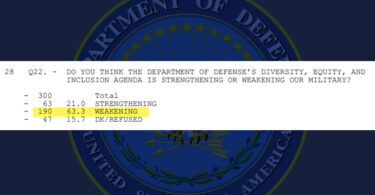By Robert Wilkie
Former Secretary of Veterans Affairs and as the undersecretary of defense for personnel and readiness. Currently serves as distinguished fellow in the Center for American Security at the America First Policy Institute.
The late 1960s and early 1970s were dark times for the U.S. Army . It imploded, collapsing in on itself after the shock of Vietnam. In the ’70s, my father was a senior officer in America’s most decorated combat force — the 82nd Airborne Division. The division was overrun by Hells Angels, Black Panthers, drug gangs, and initiates of the Fruit of Islam. Extremism was rampant, and my father had to arm himself just to enter the Fort Bragg barracks.
We are a long way from those times, both as a country and as a military. The force that broke apart after Vietnam was filled with conscripts who seethed that the burden of defending the nation had fallen solely on them, while millions protesting the war from the safety of college campuses were spared once former President Richard Nixon ushered in the all-volunteer force in lieu of the draft.
Americans are not dragooned into service, and the force looks more like the society it serves than it did during Vietnam. Sadly, however, the specter of extremism once again haunts the military — not from the effects of defeat on the battlefield, but from opportunists seeking to use the services as pawns in a cynical political game.
It is no coincidence that the lowest recruiting numbers in the 49-year history of the all-volunteer force have occurred on President Joe Biden’s watch.
The Biden administration is carefully inventing threats from within the military to disguise political attacks against administration adversaries at home. Although this does not make headlines in the way that its “woke” training or the vaccine mandates rightfully have, perhaps because the policy is implemented in highly technical manuals and “stand downs,” this administration’s counter-“extremism” efforts deserve serious and immediate attention, especially by the 118th Congress.
“Extremism” is a far more vague and pliable word than plots of violence. Indeed, for this reason, the Trump administration’s Department of Homeland Security replaced the focus on “extremism” with a focus on “targeted violence.”
Even the Biden administration and its allies admit that there is scant data to suggest extremism is currently a large or growing threat within the military. And yet, there is perhaps no more consistent part of this administration’s otherwise haphazard approach to national security than its focus on countering domestic extremism.
The department’s National Defense Strategy, released late last year, includes the following sentence in a section titled “Cultivate the Workforce We Need:” “Finally, the Department will seek to eradicate all forms of extremism in our ranks.” The NDS of the last three administrations included no such priority when it comes to military personnel and readiness.
In December 2021, Secretary Lloyd Austin’s “Countering Extremist Activity Working Group” published a report to determine the scale of the problem and the next steps. Among the report’s findings was that “cases of prohibited extremist activity among service members were rare. However, even a small number of cases can pose a significant problem, challenging safety and unit cohesion.”
An Inspector General report from May 2022 echoed this point, citing just nine “publicly reported incidents involving active and former military members linked to violent extremist or supremacist groups since January 2020.”
In fact, after investigating 2 million active and reserve troops, Austin could only report that there were less than 15 members who could be labeled as “extremists.” As my father would have attested, there were more than 15 extremists in one barrack at Fort Bragg in 1975.
Members of Congress, including leadership of committees of jurisdiction, consistently voiced concern over the course of 2021 and 2022 about the Biden administration’s focus on extremism in the military. The new chairman of the House Armed Services Committee, Mike Rogers (R-AL), cautioned that “we lack any concrete evidence that violent extremism is as rife in the military as some commentators claim.”
Congressman Mike Gallagher (R-WI), who serves as chairman of the House Military Personnel Subcommittee, noted that Austin himself “could not define ‘extremism’” when asked about it and that “[a]fter six months of study, the Pentagon has only muddled the issue more” with rules that are “ill-defined, could easily be abused, and will have the practical effect of further politicizing the force at a time when polls indicate confidence in the military is plummeting at an unprecedented rate.”
And yet, despite lacking data to justify this scale of an effort, partisan passions prevailed and guided the expansion of counter-“extremism” efforts.
In late 2022, the House Veterans Affairs Committee produced a report focused on the issue among the nation’s veterans. The report notes that “the vast majority of the nation’s approximately 18 million living veterans remain law-abiding citizens, following their military service, and the vast majority of [Domestic Violent Extremism] crimes are not committed by veterans.” Perhaps to justify the report, its authors cleverly focus on the date range of 1990–2021 (which captures the Oklahoma City Bombing in 1995 that accounts for roughly half of the 314 people killed by veterans during those three decades).
As Gallagher notes, this administration’s approach not only fails to address the problem but also directly creates a real threat to our national security on both structural and cultural levels; the demonization of millions of volunteers based exclusively on partisan political criteria.
If you were wondering why the recruitment of soldiers, sailors, airmen, and Marines is at an all-time low on Biden’s watch, add the search for phantom extremists to the debacle in Afghanistan and the balkanization of our troops along racial and sexual lines. The answer is not hard to find. Meanwhile, they are laughing in Beijing, Moscow, and Tehran.








Leave a Comment